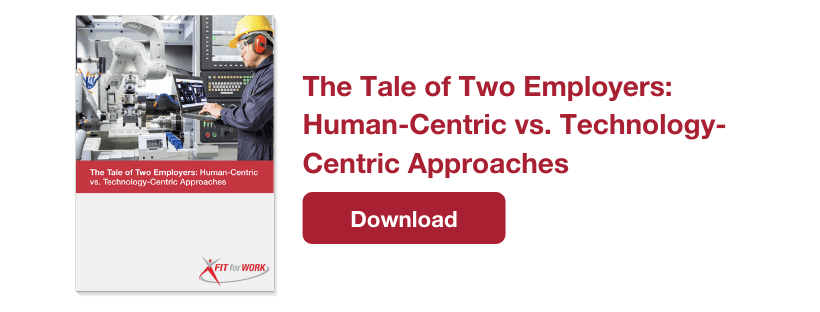Onsite Early Intervention is a proven method of reducing injuries by proactively interacting with your employees in their everyday work environments before they are injured. In doing so, providers are able to impact the three leading indicators to an injury – early soreness, ergonomics, and behaviors – and thus reduce MSDs and associated costs by 50%.
Infusing AI, Pain Science, and Ergonomics further intensifies the impact Early Intervention can have for employers, and Fit For Work is the only provider currently infusing all three of these advanced components.
Here’s how Fit For Work brings Early Intervention together with AI, Pain Science, and Ergonomics to reduce injuries for employers.
Fit For Work PREDICTS™
In recent years, Fit For Work has been pioneering the effort to bring artificial intelligence and Predictive Analytics into physical and repetitive workspaces through our Fit For Work PREDICTS™ platform.
The platform helps providers augment the Early Intervention process by interpreting current conditions and historical data to deliver insights and more accurately predict future events. Through the use of predictive algorithms, Fit For Work providers are able to leverage an additional data stream in order to make the numbers work harder for themselves and their employees.
This predictive algorithm looks at the types and frequency of interactions, quality of movements, the psychology of the worker, and his or her report history to understand where and when soreness is most likely to occur. Our Onsite Injury Prevention Specialists – and even the client safety and operational leadership personnel – are then able to proactively interact with these high-risk workers to prevent injuries before they ever take place.
While Fit For Work has been successful in intuitively identifying the correct people to intervene with for 25 years, AI provides an invaluable supporting data stream to help providers become even more accurate and impactful in their injury prevention.
Pain Science
Pain Science also integrates seamlessly with Early Intervention by recognizing there are always two threats in effect with every injured worker – the job and the pain.
Some argue that engineering is all that’s needed to solve injury issues, but this is not realistic. In reality, there is not enough space or budget to engineer solutions to solve every issue. Using Pain Science to address the worker’s perception of threats also needs to be addressed.
If an employee is stressed about their home life, their income, their job, etc., and they have back pain on top of all of that, studies show that the pain will become worse than if those other factors were not present. Simply put, happy employees that are less worried or stressed get injured less often. Infusing Pain Science within Early Intervention allows the Onsite Injury Prevention Specialist to recognize and neutralize these threats to help industrial employees be more successful in their working environment.
Ergonomics
It’s not enough for employees to be carefree if the workspace is ergonomically insufficient. Similarly, no amount of engineering or Ergonomics can do enough to make up for low morale and the perceived threats of pain. These areas need to work together to have the greatest impact.
Having a team of Certified Professional Ergonomists (CPEs) present to either support and troubleshoot with the Onsite Injury Prevention Specialists or to directly perform more complex ergonomic solutions greatly enhances the level and quality of ergonomic solutions that the client benefits from.
Fit For Work is the only organization with a Professional Ergonomics department that seamlessly integrates with Early Intervention. Together, all of these areas combine to have a game-changing impact that serves to significantly better the future of your company and your workers.
Contact us today to learn more about the difference a turnkey safety program can make in the wellbeing and productivity of your workforce.





